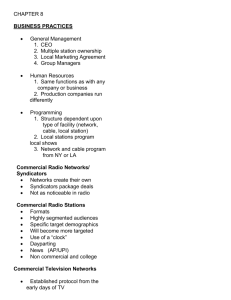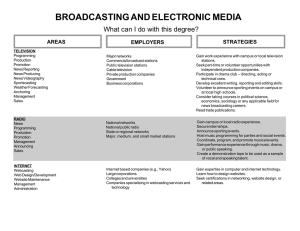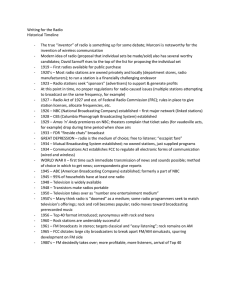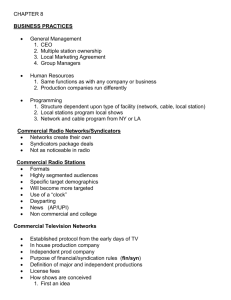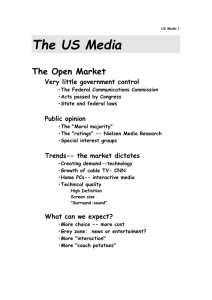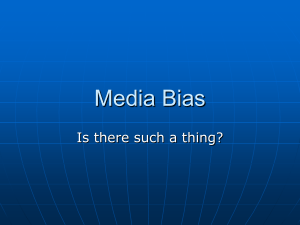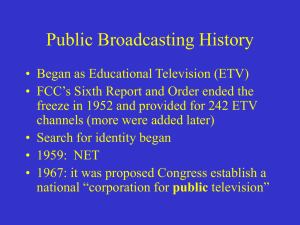comm1 tv
advertisement
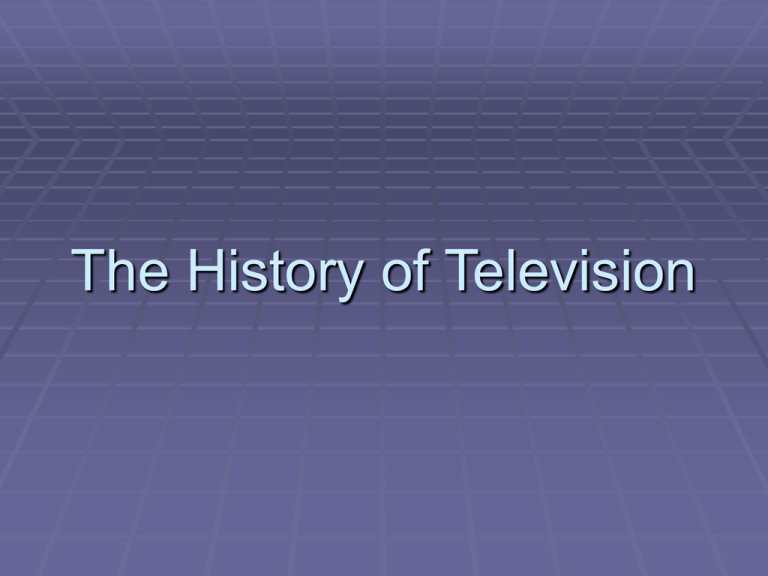
The History of Television Television Introduced to the masses at the NY World’s fair in 1939 Conflicting opinions about tv: the positives Harmless pastime Educational tool Important part of culture Television The negatives: Presents dangerously unrealistic picture of the world Promotes violence Waste of time Tv statistics % of households with at least 1 tv: 99 # of tv sets in avg. U.S. household: 2 % of U.S. homes with 3+ tv sets: 66 # of hours per day tv is on in avg. U.S. home: 6 hrs. 47 min. % of Americans that regularly watch tv while eating dinner: 66 Genres and Program Types Purpose of tv #1 to gather an audience for advertisers Also: Entertainment Information/ education Genres and Program Types Because tv programs serve to gather an audience for advertisers (yes, you are viewed as a commodity): There has been little change in programming since the beginning of tv Networks tend to stick with what has worked in the past – success copying When a certain type of program is successful on 1 network, others rush to produce a similar one Accounts for waves of popularity of certain types of shows from season to season Genres and Program Types Very few series last more than 3 yrs; many cancelled during 1st yr. Dependable programming: Soap opera: daytime tv drama Originated on radio shows; soap companies were often sponsors Crime drama CSI, NCIS, Law and Order Reality tv First shows: The Real World; Cops Currently 1 of the most-watched genres Dancing w/ Stars, American Idol, The Voice, etc. Television and Stereotypes Stereotype: The application to an entire group of the qualities of a limited sample of that group Examples of stereotypes: How does tv perpetuate stereotypes? How can we dispel stereotypes? MTV and New Production Techniques Created in 1981 as an all-music video channel for young audiences MTV strives to use capabilities of video in new ways Rapid-fire editing Hand-held camera movements Synchronizing video edits to music Integration of digital production technology/effects Broadcast Television 1350++ stations in the U.S. Channels 2-13 (VHF – very high frequency) Channels 14-83+ (UHF – ultra high frequency) # of channels available in any given area increased dramatically: Cable networks Satellite dishes Licensing Tv stations are licensed by the FCC to serve the “public interest” License must be renewed every 3 yrs 4 Major Networks Nearly 85% of all tv stations affiliated with (not owned by) 1 of the following: CBS: Columbia Broadcasting System ABC: American Broadcasting Company NBC: National Broadcasting Company Fox: Fox Broadcasting Company The most profitable stations are those affiliated with 1 of the above networks Public Broadcasting Service (PBS) A tv station that does not belong to a major network is either an independent station or a member of PBS PBS stations carry cultural and educational programming Supported by gov’t grants, donations from foundations and corporations, and contributions from individuals and groups PBS Not as dependent on advertising $ as commercial tv networks PBS stations do present messages about underwriters or supporters Independent Stations Stations that do not belong to a major network or PBS Program movies, local sports, and syndicated tv shows Networks and Local Stations Networks are not television stations; they do not broadcast programs – they supply programs to local tv affiliates via satellite Local stations must fill their own programming when networks do not supply it Networks provide programs free to the affiliates and are paid for the advertising time they can sell during the program Cost of Advertising The cost of advertising depends on the popularity of the program The more viewers, the higher the cost of advertising A small amount of time during each program is left for the local station to sell to local advertisers This advertising constitutes main source of income for local stations Cable Television Began in the late 1940’s as a solution to a problem in rural areas People paid fee to have tv set wired by cable to master antenna Good reception without expense of rooftop antenna • From isolated rural areas, tv moved to cities • Tall buildings and airplane interference impacted reception • A few cable systems offered subscribers additional channels brought in from nearby cities as added service Cable tv Offers more channels than are possible with broadcast tv Greatest benefit of cable tv: It offers a large # of channels to everyone Television Ratings Tv networks have more competition and find fewer viewers in prime time Nielson Ratings Determine a program’s future Nielson Ratings measure: How many people watched a particular show in a particular time slot What % of households with a tv watched show x How show x is rated amongst other shows aired that week Nielson Ratings The higher the rating, the higher the cost of advertising, and the higher the revenue $$$$$$ Up for Debate … Has television had a positive or negative effect on people and culture over the past 70 years? Discuss!!!!

